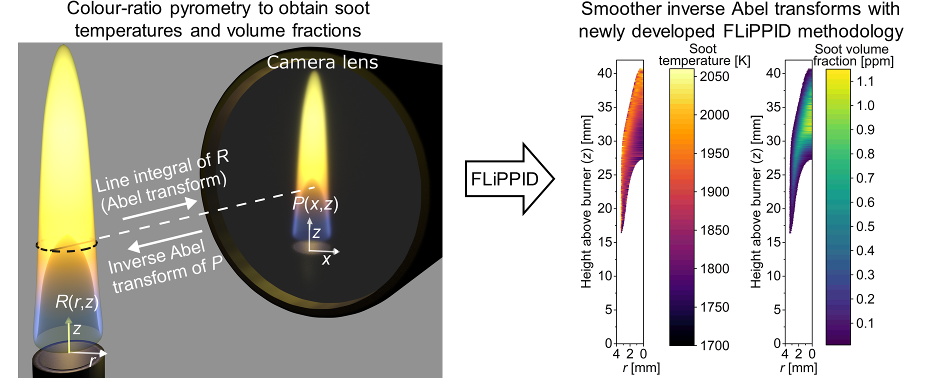Improved methodology for performing the inverse Abel transform of flame images for color ratio pyrometry
- New regression based methodology (FLiPPID) for performing the inverse Abel transform is reported.
- FLiPPID results in smoother cross-section profiles of the soot temperature and volume fraction obtained from colour-ratio pyrometry experiments.
- Methodology applicable in other experimental techniques where the 2D projection of asymmetric, optically thin objects is recorded.
 A new method is presented for performing the Abel inversion by fitting the line-of-sight projection of a predefined intensity distribution (FLiPPID) to the recorded 2D projections. The aim is to develop a methodology that is less prone to experimental noise when analyzing the projection of axisymmetric objects - in this case, co-flow diffusion flame images for color ratio pyrometry. A regression model is chosen for the light emission intensity distribution of the flame cross section as a function of radial distance from the flame center line. The forward Abel transform of this model function is fitted to the projected light intensity recorded by a color camera. For each of the three color channels, the model function requires three fitting parameters to match the radial intensity profile at each height above the burner. This results in a very smooth Abel inversion with no artifacts such as oscillations or negative values of the light source intensity, as is commonly observed for alternative Abel inversion techniques, such as the basis-set expansion or onion peeling. The advantages of the new FLiPPID method are illustrated by calculating the soot temperature and volume fraction profiles inside a co-flow diffusion flame, both being significantly smoother than those produced by the alternative inversion methods. The developed FLiPPID methodology can be applied to numerous other optical techniques for which smooth inverse Abel transforms are required.
A new method is presented for performing the Abel inversion by fitting the line-of-sight projection of a predefined intensity distribution (FLiPPID) to the recorded 2D projections. The aim is to develop a methodology that is less prone to experimental noise when analyzing the projection of axisymmetric objects - in this case, co-flow diffusion flame images for color ratio pyrometry. A regression model is chosen for the light emission intensity distribution of the flame cross section as a function of radial distance from the flame center line. The forward Abel transform of this model function is fitted to the projected light intensity recorded by a color camera. For each of the three color channels, the model function requires three fitting parameters to match the radial intensity profile at each height above the burner. This results in a very smooth Abel inversion with no artifacts such as oscillations or negative values of the light source intensity, as is commonly observed for alternative Abel inversion techniques, such as the basis-set expansion or onion peeling. The advantages of the new FLiPPID method are illustrated by calculating the soot temperature and volume fraction profiles inside a co-flow diffusion flame, both being significantly smoother than those produced by the alternative inversion methods. The developed FLiPPID methodology can be applied to numerous other optical techniques for which smooth inverse Abel transforms are required.
- This paper draws from preprint 217: Improved methodology for performing the inverse Abel transform of flame images for colour ratio pyrometry
- Access the article at the publisher: DOI: 10.1364/AO.58.002662



